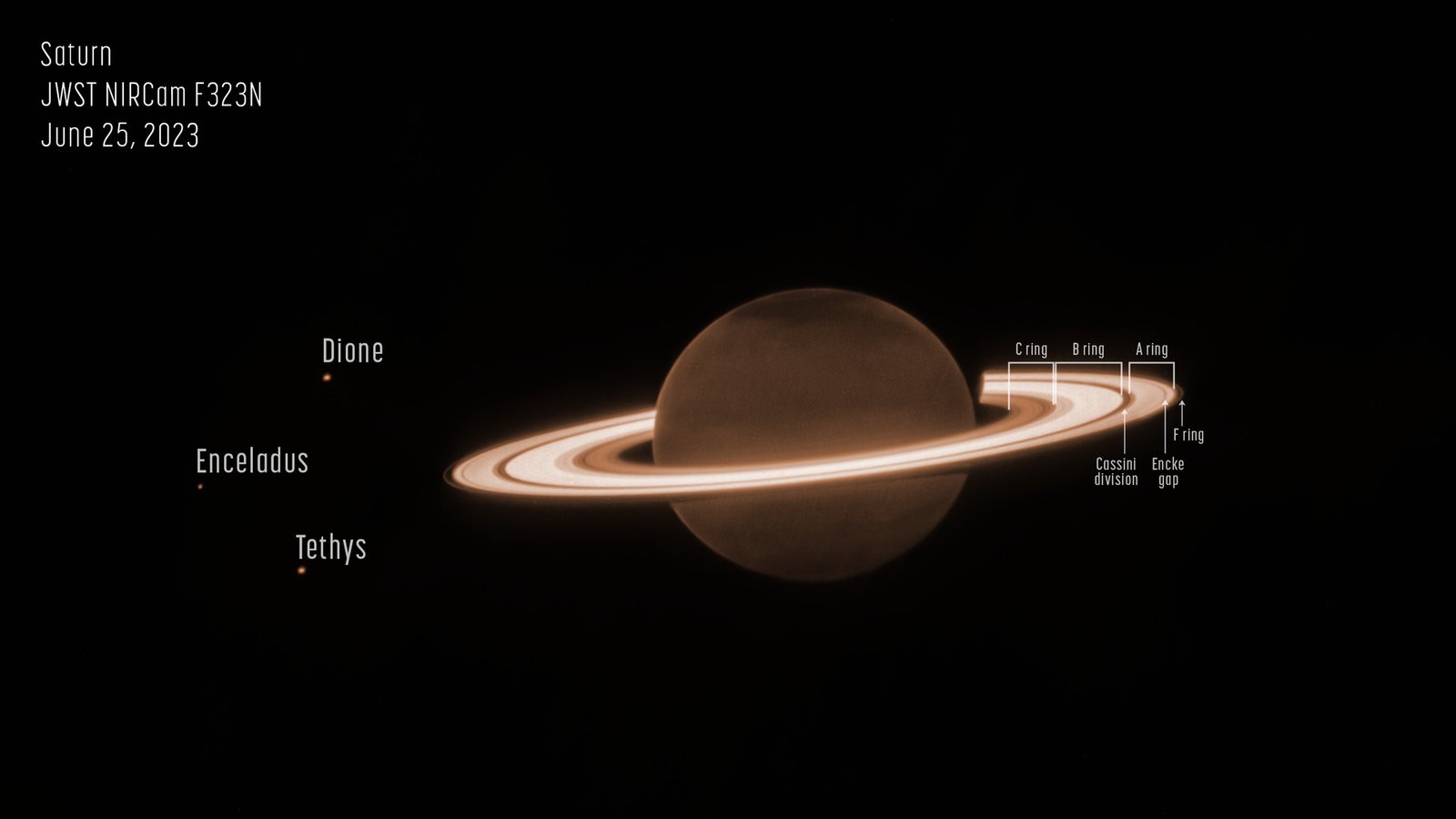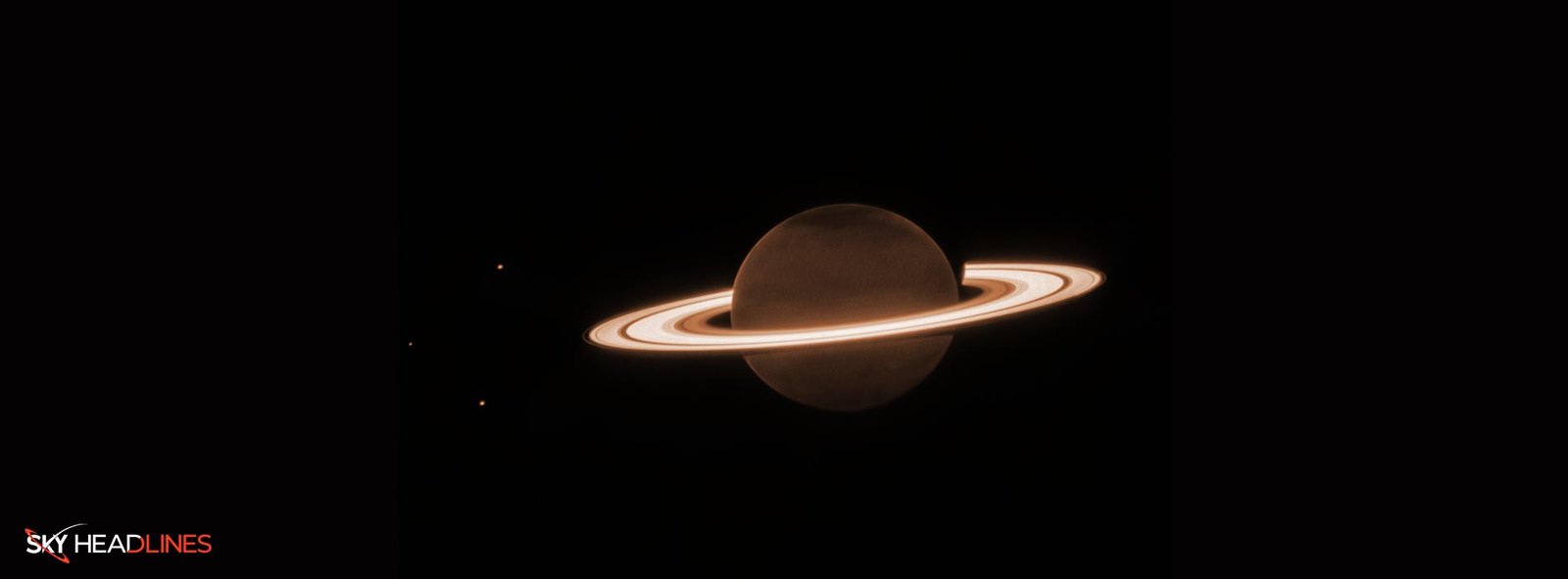NASA’s James Webb Saturn Rings pictures have been revealed on June 25, 2023. It has captured the famed ringed world Saturn for its first near-infrared observations of the planet. The initial imagery from Webb’s NIRCam (Near-Infrared Camera) is already fascinating to researchers.
What has been Revealed in the James Webb Saturn Photos?
The image shows Saturn as dark as the methane gas nearly absorbs all sunlight. NASA notes that the ring is maintaining its brightness. In contrast to Saturn, it gives the planet an “unusual appearance.”

If we look deeper into the images of James Webb Saturn 2023. Then, on the left side, you can spot Saturn’s moons:
- Dione
- Enceladus
- Tethys
Meanwhile, the right side of the images reveals:
- Cassini division
- Encke gap
- Rings A, B, C, and F
The Cassini division is the most visible gap in Saturn’s ring system. And it is also visible.
What are Some James Webb Saturn Moon Details?
The James Webb Telescope reveals the image of Saturn. It presents clear details within the planet’s ring system. And it is surrounded by some of its moons as mentioned above. Moreover, the dedicated team will be able to delve into the planet’s fainter rings. And it will be done by rough additional, and deeper exposures (not depicted here). It will be including the thin G ring and the diffuse E ring that are not visible in this picture.
Let’s Have a Clear Understanding of NASA Saturn Images & its Rings:
If we have a keen insight into the Saturn ring. Then it consists of a combination of rocky and icy fragments. And they are ranging in size from smaller than a grain of sand to some as large as Earth’s mountains. And you will be surprised by the recent findings too.
Researchers employed Webb to investigate Enceladus. And they did a discovery of a significant plume coming from the moon’s southern pole. This plume contains both particles and abundant water vapor which contributes to Saturn’s E ring. Thus, James Webb’s Saturn’s water details have also been found here.
What is the NASA’s Statement on James Webb Telescope Images 2023 of Saturn Rings?
According to NASA:
“The large, diffuse structures in the northern hemisphere do not follow the planet’s lines of latitude. So this image is lacking the familiar striped appearance that is typically seen from Saturn’s deeper atmospheric layers.”
Moreover,
Differences in the looks of Saturn’s northern and southern poles are normal. The northern region experiences summertime while the southern hemisphere is exiting winter darkness. But the darker-than-usual appearance of the northern hemisphere could be from “an unknown seasonal process affecting polar aerosols in particular.”
Is There Any Role of Saturn’s Atmosphere in the Recent Details of NASA’S Images?
The atmosphere of Saturn reveals unexpected and intriguing details. The Cassini spacecraft provides us with clearer observations of the atmosphere. This marks the first example of seeing the planet’s atmosphere with such clarity!
If you are wondering about the clarity of the image. Then it has been captured at the distinct wavelength of 3.23 microns. Which is a unique capability for Webb.
What is a Lacking Element in the Recent James Webb Saturn Images?
The images also lack some of the significant features too. It lacks the familiar striped pattern that is usually observed in Saturn’s deeper atmospheric layers. Moreover, the irregular pattern is the reflection of significant planetary waves in the stratospheric aerosols. And these are positioned high above the primary clouds. And it would also be a surprise that these patterns may be similar to those observed in the initial Webb NIRCam examinations of Jupiter. That is why James Webb Jupiter findings would also be related to these images.
Webb’s new photo is part of a series of deeply detail images. And scientists hope will reveal more about Saturn, including insights into its fainter G and E rings.
Matthew Tiscareno. A senior research scientist at the SETI Institute who did lead the process of designing the telescope’s observation of Saturn. He says in a statement.
“We look forward to digging into the deep exposures to see what discoveries may await!”
What are the Future Expectations of Scientists About the James Webb Saturn Images & Exploration?
Besides these, scientists have optimism that Webb will have the capacity to identify further moons orbiting the gas giant. And NASA’s blog post indicates it. Saturn has the highest number of known moons in the entire solar system. The recent unveiling of 62 new moons earlier this year has made another addition. And that is why now the total count is 145.
Firmly securing the planet’s position as the leader in the solar system’s “moon race.” In comparison, Jupiter, which is a runner-up, possesses 95 confirmed moons.
How do Saturn’s rings shine in Webb’s observations of a ringed planet?
Astronomers have discovered surprising details about Saturn’s atmosphere. Using a new image captured by NASA’s James Webb Space Telescope. In the image, Saturn itself appears extremely dark due to the near-total absorption of sunlight by methane gas.
Why do Saturn’s rings glow?
Methane gas absorbs almost all of the sunlight falling into the planet’s atmosphere. However, the icy rings stay relatively bright, leading to the unusual appearance of Saturn’s dark orb.
What does Saturn look like through a telescope?
Saturn’s rings give it a 3D appearance, more so than any other object you observe through a telescope. The shadows of the rings against the disc of the planet make it appear as a sphere, rather than a flat disc. You’ll also notice that the edges of Saturn appear darker than the center (limb-darkened).
Can the James Webb telescope see Saturn?
The James Webb Space Telescope has captured its stunning, first official image of Saturn and its rings.
What is the mystery behind Saturn’s rings?
The loss of the Moon was enough to remove Saturn from Neptune’s grasp and leave it with its present-day tilt. Wisdom and his team further hypothesize that fragments from the destroyed Moon settled into the planet’s orbit and formed its iconic rings.
How does Super Saturn keep its rings?
Having retrograde rotation means that the particles of the ring system are never too close to the star for too long, and thus can stay together.
What is JWST & Its Contribution to Saturn Images 2023?
The Webb Telescope is a scientific partnership between NASA, the ESA, and the Canadian Space Agency. Its purpose is to look into the studies of the cosmos. And they also reveal amazing revelations about the early universe.
They said:
“Saturn itself appears extremely dark at this infrared wavelength observed by the telescope, as methane gas absorbs almost all of the sunlight falling on the atmosphere. However, the icy rings stay relatively bright, leading to the unusual appearance of Saturn in the Webb image.”
What are Some Other Missions That have Revealed So Much About Saturn’s Atmosphere?
Exploratory missions such as:
- NASA’s Pioneer 11
- Voyagers 1 and 2
- The Cassini spacecraft
- Hubble Space Telescope
They have diligently did the monitory of Saturn’s atmosphere and rings over several decades. Do you think these experiments of James Webb Saturn would further assist astronomers in doing space exploration? If yes, then how? Let us know in the comment section below.





